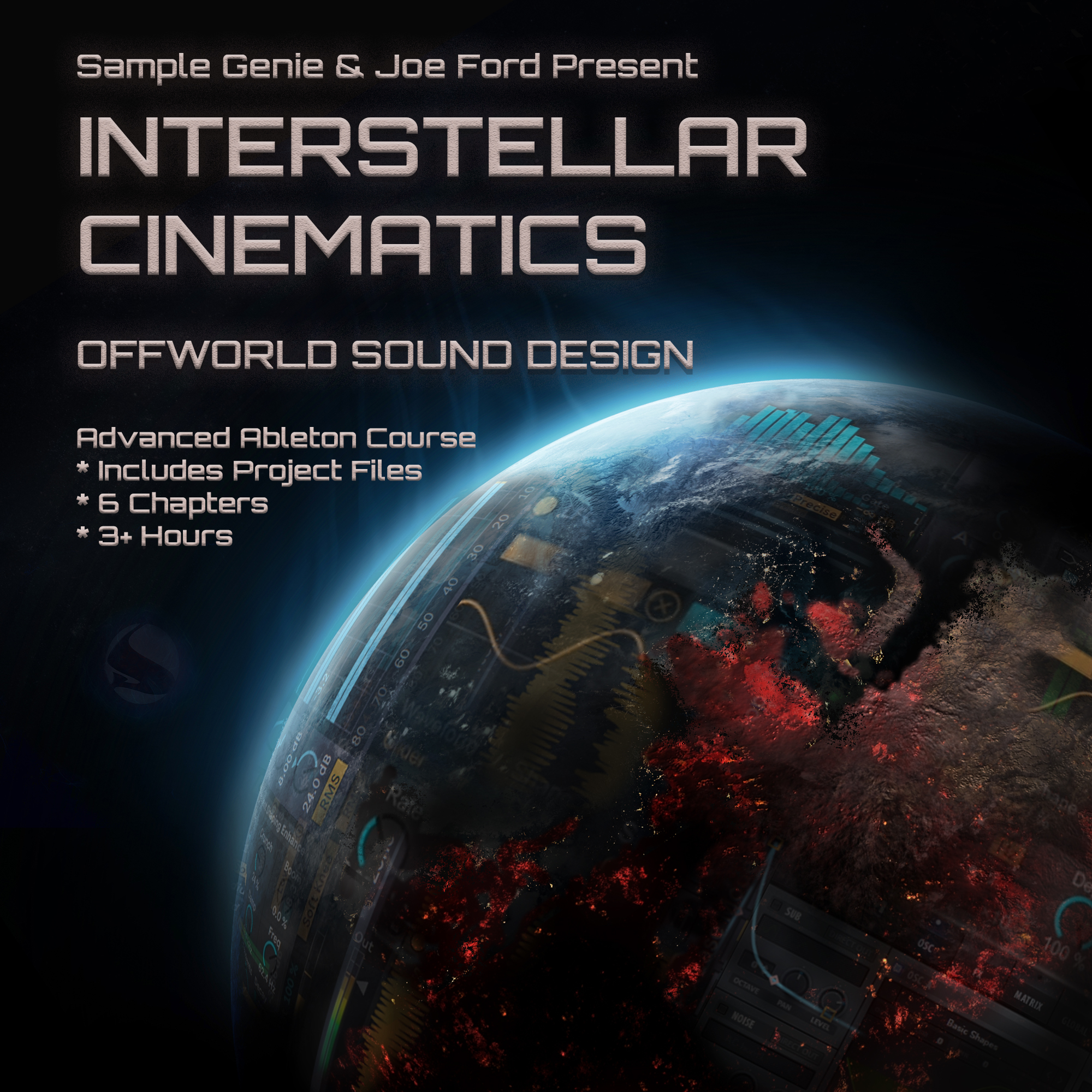Analysis of S2E01: Quadrant – "Convergence" Tutorial
- This topic has 1 reply, 2 voices, and was last updated 6 years, 6 months ago by ,
 GENIE HQ.
GENIE HQ.
-
AuthorPosts
-
-
2018-04-03 at 01:34:52 #41467,
 HarryModerator
HarryModeratorGot some downtime while at in-laws for Easter, so I wanted to get this up and also to let the forum members know I’ll be working on the Lenzman video for later this week. Looking forward to watching that, as this video might have some crossover or insight in to other methods of getting projects finished.
—
NOTESThis was the start to season 2 of Sample Genie, and was released as two parts in the month of July. These are the notes from both videos, and they are a breakdown of Quadrant, Iris & Kid Hops – “Convergence”, released on Dispatch Recordings in 2012. Quadrant’s goal for the video is to go over building tracks in a project, signal paths for track elements and busses, and how he builds individual elements (breaks, bass, atmospheres).
Part 1 (31:43 minutes)
01:30 – goes over the groups of tracks in the project:
– Drums
– Percussion
– Bass
– Keys & Pads
– Atmospheres & Transitions
– Sends/busses for Atmospheres, Instrument Out, and Drum Out02:07 – explains how the sends allow him to process the signal path of a group
02:40 – looking at drums and how he creates breaks
– Usually the first thing he does when working on a track, finds that it helps he lay down the foundation for the track.03:20 – “typical” Quadrant break, using a classic breakbeat (Jimmy McGriff – “The Worm”)
– Uses Ableton’s ‘slice to MIDI’ to map all the hits of the break to a drum rack device, where you can adjust each slice individually04:20 – explaining his slicing preset that he made
– When you chop an audio file in to a drum rack, the preset determines what parameters are mapped to the macro knobs in the device, and what the settings are on each slice’s Simpler device (NOTE: might have this incorrect, will update if necessary)
– Macro Knob —> Assigned Parameter on Simpler
– Attack —> Volume Attack
– Decay —> Volume Decay
– Sustain —> Volume Sustain
– Release —> Volume Release
– Pitch Coarse —> Drum Rack’s Coarse Pitch
– Pitch Fine —> Drum Rack’s Fine Pitch
– Sample Start —>
– Velocity —> Volume05:10 – the idea for this preset came from originally working in Logic’s EXS24 sampler, where modifying the envelope effected all slices in the EXS24. Quadrant found this to be a powerful tool for shaping the transient response of breakbeats.
05:40 – demonstrates how decay & sustain adjustments effect the sound of the break.
– Air between hits, the amount of time a hit spends at peak volume.
– Sustain relates to depth, decay relates to length06:30 – demonstrates the interplay between decay & sustain
06:45 – explains the difference between using VST sampler method versus using transient shapers on audio files
– Finds using a sampler gives him more control over how long hits go for, and taking some air out of the tails can help clean up the mix07:20 – other interesting edits to slices, swapping slices between different drum rack keys, and making layers for the main snare
– Likes his snares to have clean transients
– The original break, some of the snares have a flam to them, like a quick extra snare hit near the main snare. Swapping slices was a way to avoid using that hit.09:15 – EQ after the break’s drum rack, to remove low end and allow for a main kick layered with the break
10:00 – explains the main kick, synthesized in Logic’s Ultrabeat VST
– Examined kicks that he liked, to get an idea of his end goal for the synthesized kick
– Synthesized body, a sine wave decaying in pitch, and white noise at the beginning, creating a transient with a lot of high frequency information
– Says this is a good kick for layering11:20 – Dennis Coffey – “Scorpio” breakbeat to layer at fill-in/edit points in the break loop
12:10 – looking at drum bus processing
– Saturation —> Parallel Compression —> EQ —> Utility/Gain
– Saturation is used to distort sound a little bit
– In Quadrant’s chain, he actually had two different units, Live’s native saturator, then URS Strip Pro (32-bit only plugin)
– Parallel compression that is using an audio effect rack in Ableton, which lets you create a parallel effects chain on a track. Audio goes in and then goes through each layer in the rack. The layer with the compressed chain on it squashes the tails of the slices, bringing them up in volume, and effects the leading edges of the transients. This works best on transient heavy material, can be used on other elements too. Second layer is just a pass through layer, no processing, just the original audio signal.
– EQ to take out mud, and boost a range. Does this on a per track basis.16:30 – looking at the percussion bus
– 16-bar changes to percussion, also likes 8-bar changes as another option
– In “Convergence”, groups of percussion alternate every 16 bars17:40 – bass group
– Main bass was made in U-He Diva
– Describes as a harmonically rich sound with detuning
– LFOs modulation filter cutoff
– Diva needed some sub bass layered with it, used an instrument rack to accomplish this by running a second instrument (Kontakt) in parallel to Diva.
– Likes Kontakt’s LFO (Multi) function to create blended LFO’s.24:45 – when trying to sync two synth’s LFOs, you need to be mindful of the phase of each synth’s LFO, so not only are they in-time, but also in-phase / properly aligned
– Need LFO set to retriever with each note press
– At 27:20 he demonstrates how messy a sound can be when synth LFOs are not aligned28:25 – more on the bass, going in to the bass bus
– The bass synth track with Diva on it is routed to a bass bus
– Has an aggressive hi-shelf filter before the frequency layers are split. Mentions this after the following information though
– Bass bus has an audio effect rack with two parallel layers
– Layer 1 is the high frequency processing:
— Amp doing distortion
— Hi pass setting on EQ so the distortion does not muddy up the second layer, the low end frequencies
– Layer 2 is the low frequency processing. In this project it is just going straight through, but sometimes you put a low pass on this layer. Quadrant says he does not think using a low pass makes much of a difference in this project.29:45 – explains a track in the bass group called C4C Auto, which on its own does not sound like much, but layered with the rest of the bass, adds to the sound and movement of the bass.
Part 2 (21:42 minutes long)
00:20 – says the keys & pads are not super interesting, but does want to look at the processing on the bus
– Two side chain compressors, first one triggered by the main kick, the second by one of the main snare layers
– Each compressor has slightly different ratios and attack settings
– Uses the compressors to give the kick and snare headroom
– Compressor one has a -21.5 dB threshold, while compressor two on the snare has a higher threshold at -42.8 dB
– Short release is barely audible, but does a good job of giving drums room before other sonic elements04:45 – general mix down strategies
– “Hi pass everything, unless you have a reason not to.”
– Pads, keys, and atmospheres do not have any presence below 100 Hz09:30 – example of a ride with a lot of low end content that is not necessary, would eat up a lot of headroom if it was not filtered out
11:30 – default tracks pre-loaded with hi-pass EQ already set-up
12:05 – instrument out bus
– All of the non-drum elements
– Basically anything with out complex transient information13:00 – wants a limiter across all sounds with out transients
– Clamping down on any peaks
– Hits 0 dB and no intentional distortion15:10 – drum out bus
– All of the drum groups feed in to this bus
– Quadrant does not feel that drums going in to the red on meters is necessarily bad
– He knows this is often frowned upon, but in practice, he has liked how it sounds on drums
– Master out has a distortion stage
– Transients / leading edge of drums clipped, but then body of the drum is not clipped. There is psychoacoustic nature to this, transients are often perceived as noise.
– Keeping transients close in amplitude to the body of the drum hit20:00 – explains how the instrument bus & drum bus sum together on the master output bus
– Master meter shows clipping, but it actually sounds good
– Being careful with sidechaining, where “steady state” sounds (e.g. all of the non-drum sounds) are getting out of the way of transient heavy sounds, and making sure the transient heavy sounds are not too hot out of the master out
– To test transient heavy sounds, solo & make sure they are not audibly distorting; use your ears, not the meters—
THOUGHTS & QUESTIONS– Controlling a drum hits envelope via ADS vs. ADH, how similar? ADH is Attack Decay Hold, often described as good for drum hits. The past few months I have been shaping my main drum hits with ADH parameters.
– In Bitwig, you can have layered synths in a container, and instead of each synth having their internal LFOs and trying to sync them, you could use a modulator (it’s a Bitwig device feature), and then assign that to each synth’s parameter. I’m pretty sure Ableton has Max4Live tools that can do this. Example in my head is synth 1 is sub bass, synth 2 is midrange, then a single LFO modulator assigned to the filter cutoff in both synths.
– The part about the C4C Auto track, that is probably a good way to make my bass more interesting over the time of a song.
– A year ago I was talking with Quadrant, asked if he had any tips for production, and he simply said “don’t be afraid of going in to the red.” I get it now, after rewatching this and having a bit more perspective on production.
– Recently talked with Quadrant, and while he still uses ADS envelopes to shape drum hits, he also has been using multi-band gating as a tool to clean up mud from drum hits, and let a bit more air through, making for more natural sounding drum hits.
"Knowledge kept is knowledge lost." - Bobbito Garcia
-
2018-04-03 at 11:22:10 #41476,
 GENIE HQKeymaster
GENIE HQKeymasterBig up!
(and thanks for fixing the order of the analysis posts in the sticky! Accidentally deleted season 2… you found a clever way of addressing that 😉
-
-
AuthorPosts
- You must be logged in to reply to this topic.


